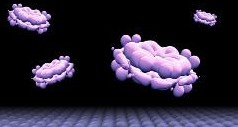The group of researchers from Rice University discovered the ability to "tear off" hydrogen atoms from a two-dimensional sheet of graphene, a finding that will surely promote innovative areas of activity for the use of such graphene as quantum dots

Graphene is the material of choice for physicists for materials at the forefront of science, and researchers at Rice University are at the forefront of this front.
The group of researchers, led by Boris Yakobson, professor of mechanical engineering and materials science and chemistry, discovered the ability to "tear off" hydrogen atoms from a two-dimensional sheet of graphene, a finding that will certainly promote innovative areas of activity for the use of such graphene as quantum dots.
The finding opens a window to a new world of possibilities for types of nanoelectronic components on the smallest scale, components that depend on the highly controlled semiconducting properties of quantum dots, especially in the field of advanced optics.
The research findings were published in the scientific journal ACS Nano, when Rice University was recently named the leading institution in materials science research by a British journal.
Graphene, with hydrogen atoms added to both sides, turns from a conductor into an insulator. Although the thickness of the material is a single atom, graphene provides many possibilities for changing its semiconducting properties.
quantum dots (Quantum dots, the Wikipedia entry) are crystalline particles consisting of a few to many atoms, which react with light and magnetic fields in unique ways. The size of the dot determines the gap of the bars - or in simple words - the amount of energy required to close an electrical circuit - and can be adjusted at very precise levels. The frequencies of light (and energy) emitted by the active points make them particularly useful for chemical sensors, solar cells, medical imaging and nanoscale electrical circuits.
The researchers calculated and found that removing "islands" of hydrogen atoms from both sides of the graphene would lead to obtaining complexes with the properties of quantum dots, a finding that could also lead to the development of arrays of dots for many and varied applications.
"We arrived at these ideas from a completely separate study of energy storage in the form of adsorption of hydrogen atoms in graphene," says the researcher. "The researchers in the group realized that this phase transition - from conducting graphene to insulating graphene, accompanied by the transition from "metal" to insulator, provides an innovative collection of developments for nanoengineering."
The study revealed several interesting features. The researchers found that when "blocks" of sublattice hydrogen are removed, the remaining complex always exists as a hexagonal structure, with a clear interface line between the two types of graphene. This finding is important, they say, because it leads to the conclusion that each point is highly circumscribed; Calculations show that there is very little "leakage" of charge into the host material (graphane).
"You get an atom-like spectrum inside the material, and then the band gap can be changed by changing the size of the spot," explains the researcher. "Thus, in the end, the optical properties of the material can be adjusted."
Besides the optical applications, the dots may be useful for single-wavelength sensing and may lead to the development of very tiny semiconductor transistors and lasers, the researcher notes.
There are still challenges such as understanding how to make arrays of quantum dots in a graphene sheet, but the researchers do not believe that these bumps cannot be overcome.

2 תגובות
This is fascinating news. And it is less in the world of chemistry and more in the world of lasers and semiconductors. Nano dots are more or less the hottest field in SSD today.
The question is, is such news interesting to the general public and worthy of publication? Not every new piece of news in the world of chemistry is fascinating. But I guess it doesn't hurt to post.